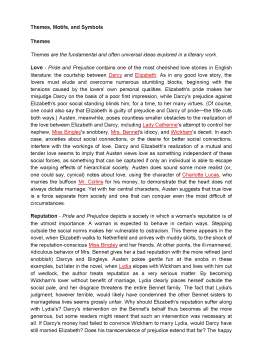Extras din referat
Themes, Motifs, and Symbols
Themes
Themes are the fundamental and often universal ideas explored in a literary work.
Love - Pride and Prejudice contains one of the most cherished love stories in English literature: the courtship between Darcy and Elizabeth. As in any good love story, the lovers must elude and overcome numerous stumbling blocks, beginning with the tensions caused by the lovers' own personal qualities. Elizabeth's pride makes her misjudge Darcy on the basis of a poor first impression, while Darcy's prejudice against Elizabeth's poor social standing blinds him, for a time, to her many virtues. (Of course, one could also say that Elizabeth is guilty of prejudice and Darcy of pride—the title cuts both ways.) Austen, meanwhile, poses countless smaller obstacles to the realization of the love between Elizabeth and Darcy, including Lady Catherine's attempt to control her nephew, Miss Bingley's snobbery, Mrs. Bennet's idiocy, and Wickham's deceit. In each case, anxieties about social connections, or the desire for better social connections, interfere with the workings of love. Darcy and Elizabeth's realization of a mutual and tender love seems to imply that Austen views love as something independent of these social forces, as something that can be captured if only an individual is able to escape the warping effects of hierarchical society. Austen does sound some more realist (or, one could say, cynical) notes about love, using the character of Charlotte Lucas, who marries the buffoon Mr. Collins for his money, to demonstrate that the heart does not always dictate marriage. Yet with her central characters, Austen suggests that true love is a force separate from society and one that can conquer even the most difficult of circumstances.
Reputation - Pride and Prejudice depicts a society in which a woman's reputation is of the utmost importance. A woman is expected to behave in certain ways. Stepping outside the social norms makes her vulnerable to ostracism. This theme appears in the novel, when Elizabeth walks to Netherfield and arrives with muddy skirts, to the shock of the reputation-conscious Miss Bingley and her friends. At other points, the ill-mannered, ridiculous behavior of Mrs. Bennet gives her a bad reputation with the more refined (and snobbish) Darcys and Bingleys. Austen pokes gentle fun at the snobs in these examples, but later in the novel, when Lydia elopes with Wickham and lives with him out of wedlock, the author treats reputation as a very serious matter. By becoming Wickham's lover without benefit of marriage, Lydia clearly places herself outside the social pale, and her disgrace threatens the entire Bennet family. The fact that Lydia's judgment, however terrible, would likely have condemned the other Bennet sisters to marriageless lives seems grossly unfair. Why should Elizabeth's reputation suffer along with Lydia's? Darcy's intervention on the Bennet's behalf thus becomes all the more generous, but some readers might resent that such an intervention was necessary at all. If Darcy's money had failed to convince Wickham to marry Lydia, would Darcy have still married Elizabeth? Does his transcendence of prejudice extend that far? The happy ending of Pride and Prejudice is certainly emotionally satisfying, but in many ways it leaves the theme of reputation, and the importance placed on reputation, unexplored. One can ask of Pride and Prejudice, to what extent does it critique social structures, and to what extent does it simply accept their inevitability?
Class - The theme of class is related to reputation, in that both reflect the strictly regimented nature of life for the middle and upper classes in Regency England. The lines of class are strictly drawn. While the Bennets, who are middle class, may socialize with the upper class Bingleys and Darcys, they are clearly their social inferiors and are treated as such. Austen satirizes this kind of class-consciousness, particularly in the character of Mr. Collins, who spends most of his time toadying to his upper class patron, Lady Catherine de Bourgh. Though Mr. Collins offers an extreme example, he is not the only one to hold such views. His conception of the importance of class is shared, among others, by Mr. Darcy, who believes in the dignity of his lineage; Miss Bingley, who dislikes anyone not as socially accepted as she is; and Wickham, who will do anything he can to get enough money to raise himself into a higher station. Mr. Collins's views are merely the most extreme and obvious. The satire directed at Mr. Collins is therefore also more subtly directed at the entire social hierarchy and the conception of all those within it at its correctness, in complete disregard of other, more worthy virtues. Through the Darcy-Elizabeth and Bingley-Jane marriages, Austen shows the power of love and happiness to overcome class boundaries and prejudices, thereby implying that such prejudices are hollow, unfeeling, and unproductive. Of course, this whole discussion of class must be made with the understanding that Austen herself is often criticized as being a classist: she doesn't really represent anyone from the lower classes; those servants she does portray are generally happy with their lot. Austen does criticize class structure but only a limited slice of that structure.
Preview document
Conținut arhivă zip
- Themes, Motifs and Symbols.doc
















